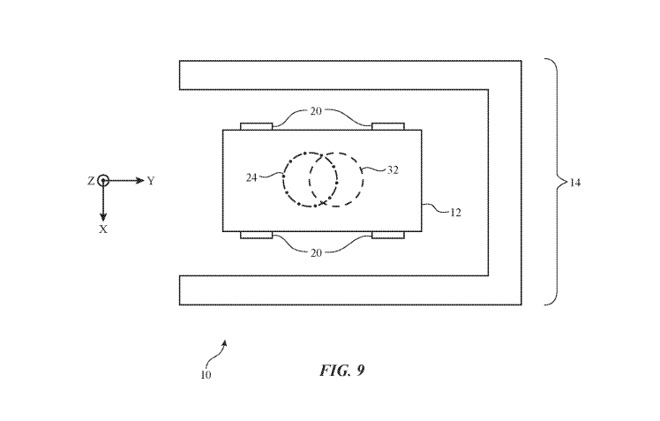Apple working on self-driving car wireless charging technologies
Possibly suggesting grand ambitions for an Apple car, a patent application published on Thursday shows a wireless charging system for self-driving vehicles.

Titled "Wireless Charging Alignment Systems," U.S. patent application 20190210480 describes a car in which "control circuitry may use the steering and propulsion system to park the vehicle in a parking space," where "wireless power may be transferred from a wireless power transmitter in the parking space to a wireless power receiver coupled to a vehicle body." Sensors would record transmitter alignment and efficiency, using this data to better optimize parking later on.
"Vehicle parking position may be intentionally varied over a series of parking events to gather additional alignment information," Apple adds.
The application was originally submitted in March and credits several inventors, among them Jeff Alves, a senior hardware engineering manager at Apple, and Derryk Davis, a product design engineer.
Most notable may be Hunter Wu, a senior power engineer at the company's secretive Special Projects Group. Wu has been with the company since Dec. 2015, and was previously a chief science officer at WAVE -- standing for Wireless Advanced Vehicle Electrification. That firm created wireless chargers for electric buses.
It's widely anticipated that any "Apple Car" will be an EV given industry trends, Apple's penchant for environmental causes, and a lack of experts in combustion engines. The company is known to be testing self-driving systems, and recently bought out self-driving car startup Drive.ai.
Still up in the air is when a finished vehicle might hit the roads. While once anticipated as soon as 2020, a release now isn't expected until at least 2023.

Titled "Wireless Charging Alignment Systems," U.S. patent application 20190210480 describes a car in which "control circuitry may use the steering and propulsion system to park the vehicle in a parking space," where "wireless power may be transferred from a wireless power transmitter in the parking space to a wireless power receiver coupled to a vehicle body." Sensors would record transmitter alignment and efficiency, using this data to better optimize parking later on.
"Vehicle parking position may be intentionally varied over a series of parking events to gather additional alignment information," Apple adds.
The application was originally submitted in March and credits several inventors, among them Jeff Alves, a senior hardware engineering manager at Apple, and Derryk Davis, a product design engineer.
Most notable may be Hunter Wu, a senior power engineer at the company's secretive Special Projects Group. Wu has been with the company since Dec. 2015, and was previously a chief science officer at WAVE -- standing for Wireless Advanced Vehicle Electrification. That firm created wireless chargers for electric buses.
It's widely anticipated that any "Apple Car" will be an EV given industry trends, Apple's penchant for environmental causes, and a lack of experts in combustion engines. The company is known to be testing self-driving systems, and recently bought out self-driving car startup Drive.ai.
Still up in the air is when a finished vehicle might hit the roads. While once anticipated as soon as 2020, a release now isn't expected until at least 2023.

Comments
This description would possibly block all inventive applications, thats a shame and totally unfair for inventors not having the money to preemptive block this.
https://www.pluglesspower.com/
claiming others do it too.
Depends where the energy comes from. I remember years back reading that Apple has a large reservoir of green energy collected by solar.
There isn't. Neither is there Apple Glasses.
The reason it looks obvious is because neither you or Googleguy bothered to read the patent application, so neither of you really understand what the patent is for.
For those with short attention spans:
The idea is for a car to be parked over a charging point over a number of random offset points. Each parking event measures the efficiency of the charging cycle which is then used to optimise the auto parking action (which still has to account for obstacles, including idiots standing on or near the charging circle) of the car to make sure as little power as possible is wasted while the car is charging.
Finding a charge point: easy. My lawnmower can do that.
Parking over that charge point (given that there may be obstacles around it) so that power isn't wasted over a charge cycle. Not so easy, but very important for a company that prides itself on its street gred. (Gred = Green Credentials; see what I did there?)
Finding a company that cares enough about the environment to spend money on such painstaking research that won't yield any revenue or allow them to monetise their customers' personal data. Really hard.
Christ on a bicycle
🤦🏾♂️
This isn't a patent for wireless charging.
Those things can really shift …
Also, here's a great EV channel on YouTube
Yes, it stars Robert Llewellyn, Kryten from Red Dwarf.
I was not assuming the article was simply about wireless charging, but was a way to optimize it [for autonomous vehicles as indicated in title, but seems like semi-autonomous application similar to "parking assist" could take advantage of this]. Your other comment explains the patent application quite nicely, so thanks for that!
And if Christ was on an electric bicycle, think how much happier he would be knowing that he could park and charge most efficiently.
As far as i know only one of the huge US techs has so far achieved 100% sourcing of renewable energy for consecutive years and it is not Apple.
What do you do that wastes energy? C’mon there must be something. What’s your thermostat set to?
O rly?
https://www.apple.com/newsroom/2018/04/apple-now-globally-powered-by-100-percent-renewable-energy/
https://www.popularmechanics.com/science/energy/a19746117/apple-100-percent-renewable-energy/